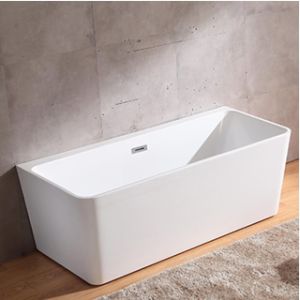What're your thoughts and feelings about A Step-by-Step Guide to Installing a Bathtub?

Mounting a tub isn't precisely brain surgery, but it does call for solid plumbing, woodworking, and also often, tiling skills. Changing an old bathtub with a new one is likewise a reasonably hard project. If the old bathtub is readily easily accessible, the job can move easily; if you need to open up a wall to eliminate the old tub and also place the new bathtub, the job is much harder. In either situation, the project is within a residence handyman's skills, although you will require a helper to leave the old tub as well as embeded in the new one. Ensure you have actually certified yourself for the work and are comfortable attempting it. Instead of hiring a professional to take control of a halfway-completed task, it is better to take into consideration using one prior to you begin. Opportunities are you may require an expert plumber to make tube connections.
This post will assist you install a new tub in your restroom if you have actually currently purchased a new tub and also don't need to alter the plan of your previous water system pipelines.
Your devices and material checklist need to make up the following:
Removing Old Taps
If you need to change old taps with brand-new ones as a part of your installment, then the first thing you should do is detach the water. After doing so, switch on the taps to drain pipes any kind of water continuing to be in the system. The process of eliminating the existing taps can be rather problematic because of the limited gain access to that is frequently the instance.
Utilize a container wrench (crowsfoot spanner) or a tap device to reverse the nut that connects the supply pipelines to the faucets. Have a fabric prepared for the continuing to be water that will come from the pipes. Once the supply pipes have actually been eliminated, utilize the same device to loosen up the nut that holds the faucets onto the bath/basin. You will certainly require to quit the solitary faucets from transforming throughout this process. Once the taps have actually been gotten rid of, the holes in the bath/basin will certainly need to be cleansed of any kind of old securing compound.
Before moving on to fit the brand-new taps, compare the pipeline links on the old taps to the brand-new faucets. If the old faucets are longer than the brand-new taps, then a shank adapter is needed for the new faucets to fit.
Suitable New Touches
If the tails of the new faucets are plastic, after that you will require a plastic port to avoid damage to the thread. One end of the connector fits on the plastic tail of the tap and the various other end offers a link to the current supply pipes.
If you require to fit a monobloc, after that you will call for minimizing couplers, which attaches the 10mm pipe of the monobloc to the typical 15mm supply pipeline.
Next, place the tap in the mounting hole in the bath/basin ensuring that the washers are in location between the faucet and also the sink. Safeguard the tap in place with the producer supplied backnut. As soon as the faucet is securely in place, the supply pipes can be linked to the tails of the faucets. The faucets can either be connected by using corrugated copper piping or with regular tap ports. The previous type should be attached to the faucet ends first, tightening up just by hand. The supply pipes can later be linked to the various other end. Tighten both ends with a spanner after both ends have actually been attached.
Installing the Bathtub
Utilizing the two wood boards under its feet, put the bathtub in the required setting. The wood boards are helpful in uniformly spreading the weight of the tub over the location of the boards as opposed to concentrating all the weight onto four tiny factors.
The following goal is to ensure that the tub is leveled all round. This can be achieved by inspecting the level and changing the feet on the bath tub till the spirit level checks out degree.
To mount faucets, fit the bottom of the furthest adaptable tap connector to the suitable supply pipe by making a compression join; after that do the exact same for the various other faucet.
Activate the water system and also check all joints and brand-new pipework for leakages and also tighten them if essential. Load the bathtub and also inspect the overflow electrical outlet as well as the regular outlet for leakages.
Ultimately, take care of the bath paneling as described in the manufacturer's user's manual. Tiling and also sealing around the bathtub needs to wait up until the bathtub has been used at least when as this will resolve it right into its final placement.
Planning for the Installation
To start with, the supporting framework provided with the bath must be fitted (if required) according to the maker's guidelines. Next, fit the taps or mixer to the bath tub. When fitting the tap block, it is essential to see to it that if the faucet comes with a plastic washer, it is fitted in between the bathroom and also the taps. On a plastic bath, it is also reasonable to fit a sustaining plate under the faucets unit to avoid strain on the bath tub.
Fit the adaptable tap ports to the bottom of both taps utilizing 2 nuts and also olives (sometimes supplied with the bathtub). Fit the plug-hole outlet by smearing mastic filler round the sink electrical outlet opening, and then pass the electrical outlet through the hole in the bathroom. Use the nut supplied by the maker to fit the plug-hole. Analyze the plug-hole electrical outlet for an inlet on the side for the overflow pipeline.
Next, fit the end of the flexible overflow pipeline to the overflow outlet. Afterwards, screw the pipe to the overflow face which ought to be fitted inside the bathroom. Ensure you use all of the provided washing machines.
Link the trap to the bottom of the waste electrical outlet on the bathtub by winding the string of the waste electrical outlet with silicone mastic or PTFE tape, and screw on the catch to the outlet. Link all-time low of the overflow tube in a similar manner.The bathroom need to now be ready to be suited its last position.
Tiling Around the Tub
In the area where the bath satisfies the ceramic tile, it is required to secure the accompanies a silicone rubber caulking. This is necessary as the fitting can move sufficient to fracture a rigid seal, triggering the water to penetrate the wall surface between the bathroom and also the tiling, bring about complications with dampness and feasible leakages to the ceiling below.
You can select from a range of coloured sealants to blend in your components as well as fittings. They are offered in tubes and cartridges, and also can sealing voids up to a size of 3mm (1/8 inch). If you have a bigger gap to load, you can fill it with spins of soaked paper or soft rope. Bear in mind to always fill the bath tub with water before securing, to allow for the activity experienced when the tub remains in use. The sealer can split fairly early if you do not consider this motion prior to sealing.
Additionally, ceramic coving or quadrant floor tiles can be used to edge the bath or shower tray. Plastic strips of coving, which are easy to use as well as reduce to dimension, are additionally easily offered on the marketplace. It is suggested to fit the tiles utilizing waterproof or waterproof adhesive and grout.
A Step-by-Step Guide to Installing a Bathtub
Is your bathtub looking a bit dated lately? Believe it or not, installing a new one is a project you can do yourself. Whether your bathtub is broken or doesn’t fit in with your current bathroom’s design, you can fix it without having to hire a contractor or paying labour costs.
But, beyond saving money, there are other benefits of installing your own bathtub. When you do this project yourself, you can customise every step of the process. You can also make sure the finished product looks exactly the way you want it to.
This DIY project is quite involved, but by doing some research, preparing your bathroom and using the right equipment, it is definitely one you can take on. This guide will help you understand the technical procedures behind installing a new bathtub.
Remove the Existing Bathtub
To remove the old bathtub, you will need to turn the water supply off before you start any work. After you turn the water off, there will likely still be some water left in your plumbing system, which you can remove by turning on a faucet below the level of the bathtub. Once the water stops running, you are ready to start working.
The easiest way to remove the tub is to remove the faucet, handles and other piping and then pull the tub out from the wall. If this doesn’t work in your situation, you will need to remove part of the wall, remove the piping and then slide the tub out.
Choose the Right Bathtub
The ideal way to replace your bathtub is to find one that has the exact dimensions and has the drain and faucet on the same side as your old one. This way, it will fit in the same place and you won’t have to change the piping system in your bathroom. Choose a tub that matches your home’s decor and fits with the style of the bathroom.
Install the Plumbing and Ledger Board
You can purchase a tub drain kit at a hardware store which will have all the pieces you will need for your new tub’s plumbing. Follow the instructions that came with the kit to install the plumbing in the new tub and then take measurements to make sure the plumbing in the tub will align with the plumbing in your bathroom. If it doesn’t, now is the time to make necessary adjustments.
Some bathtubs need a ledger board that is installed on the wall behind the tub to help support it. If your new bathtub requires one, the directions that came with it will tell you how high it should be installed. If your old bathtub had a ledger board, and it is still in good condition, you can adjust its height to match the new bathtub.
Install the Bathtub
When the plumbing and ledger board are ready, you can install the new bathtub. Carefully lower it into the space, being careful not to damage the tub, wall, plumbing or ledger board. Since bathtubs are very heavy and you will need to line the tub up exactly, it is wise to have someone help you with this step.
Once the tub is in place, it needs to be perfectly level, so use a bubble level instead of estimating how level the tub is. Put the level on the top edge of the tub, not the bottom on the inside, since many tubs are designed with a sloped bottom.
If the bathtub isn’t level, adjust the ledger board and shift the tub until it is. When it is level, use screws to attach the tub to the wall studs. Most bathtubs have pre-drilled holes in the upper flange, so use these but do not over tighten the screws.
Hook up the Plumbing
Now that the bathtub is installed, it needs to be attached to your plumbing system. First, install the shoe fitting under the tub and drain pipe, then the overflow pipe and then the drain flange. Your tub plumbing kit will include specific instructions on how to install these pieces.
Install the Bathtub Surround
A bathtub surround will protect the walls around the tub from water damage and can give your new bathtub a more finished look. To install one, make sure the wall is completely clean and dry so that the adhesive will be able to hold the surround securely. Then, measure the surround and mark the same dimensions on the wall above the tub.
Following the directions that came with the surround adhesive, apply it to the wall. Press the surround against the wall on top of the adhesive and then pull it away for about three minutes to activate the adhesive, then apply the surround again. Keep in mind that this is the most common way to use an adhesive, but you should check the instructions on the package for any special steps.
If there is any excessive adhesive around the sides of the surround, you can use mineral spirits to remove it. Then use masking tape to hold the surround panels in place until the adhesive is dry. Using silicone, seal all the cracks between the surround panels and the gap between the bottom of the panels and the top of the bathtub.
If you want to install tile above your bathtub, instead of a bathtub surround, the process will be very similar. But, you will need to measure and cut tiles and install each one individually, using tile spacers to make sure they are evenly spaced. You will then use grout to fill in the spaces between the tiles.
https://www.hss.com/blog/bathroom/a-step-by-step-guide-to-installing-a-bathtub/

Do you appreciate reading up on How to Install a Bathtub? Create feedback further down. We would be delighted to hear your ideas about this entry. We are looking forward that you come back again soon. Appreciated our article? Please share it. Help others check it out. Kudos for your time. Come back soon.
Stress less, ring us.
 Anna Chlumsky Then & Now!
Anna Chlumsky Then & Now! Bug Hall Then & Now!
Bug Hall Then & Now! Tahj Mowry Then & Now!
Tahj Mowry Then & Now! Elisabeth Shue Then & Now!
Elisabeth Shue Then & Now! Nicholle Tom Then & Now!
Nicholle Tom Then & Now!